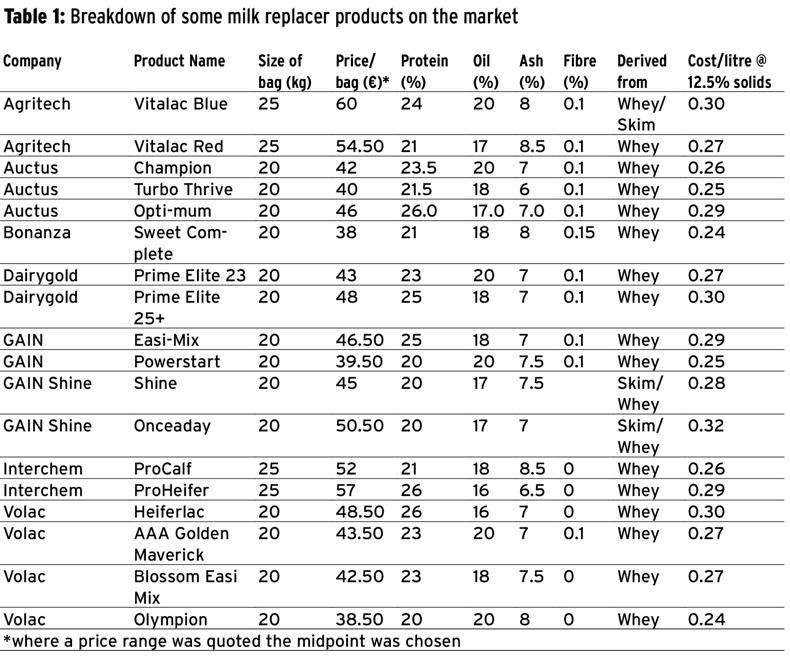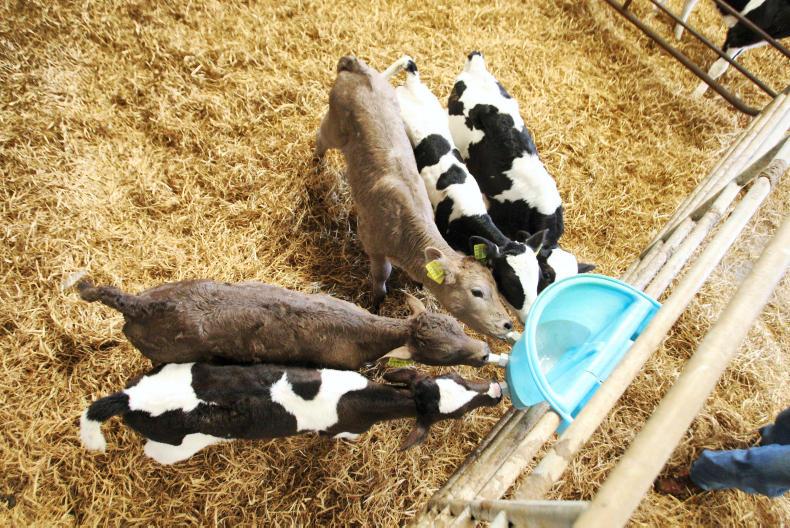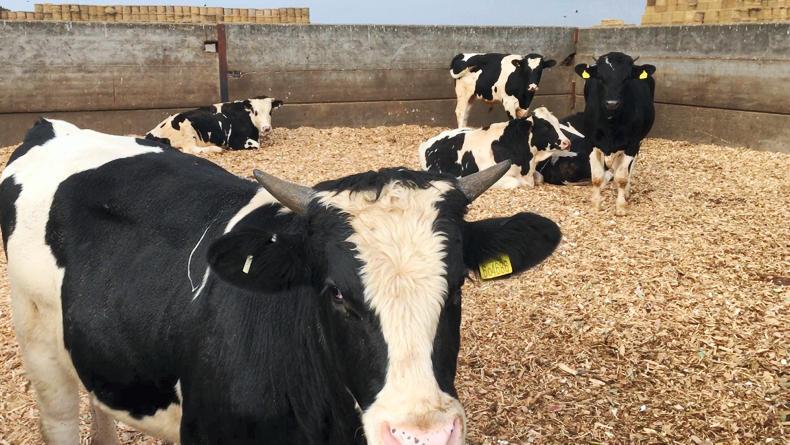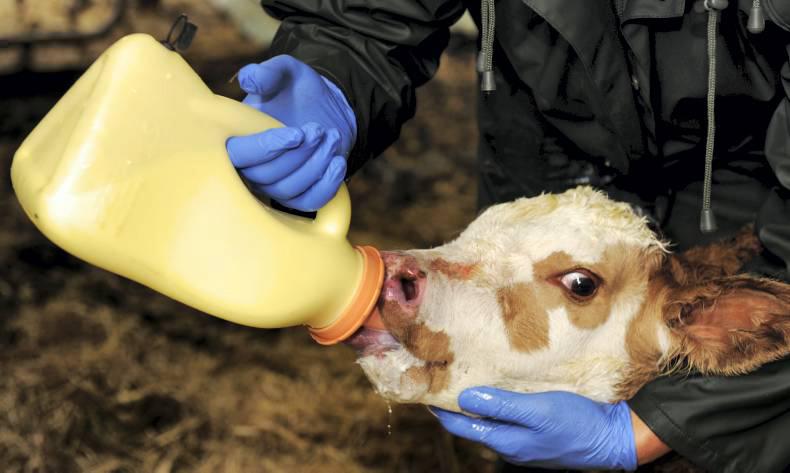It is usually more than just price that determines whether you use milk replacer over whole milk. While it may be more economical to use milk replacer this year, you must also take into account the labour requirements of feeding milk replacer over whole milk.
You should also consider the effects on calf growth, as some lower-spec milk replacers are inferior to whole milk. On the plus side, milk replacers tend to be more consistent than whole milk. While the constituents of whole milk vary depending on the diet of the herd and their stage of lactation, the constituents of milk replacer are much more stable.
On top of that, they are also more bio-secure. We know that Johne’s disease, for example, can be transmitted in unpasteurised milk but not transmitted in milk replacer. For this reason, the use of milk replacers is a key part of any Johne’s disease control programme.
It also has a lower fat content so it encourages the early intake of concentrates.
Of course, beef farmers who buy dairy calves for rearing have no alternative but to use milk replacers. It is the same for farmers who have invested in automatic calf feeders – the majority of these only feed milk replacer.
How to do it
Feeding milk replacer is simple and straightforward. Problems with feeding milk replacer usually come about as a result of a problem with the mixing of the powder.
The important thing is to use the right approach, stick with it and be consistent throughout the rearing process. Making big alterations in the middle of the rearing period can cause stress to the calf and could result in scours or a loss of thrive.
If you need to make changes, introduce them gradually to prevent stress and monitor the transition carefully. Ideally, you shouldn’t need to make any changes once the plan has been well thought out. If a change needs to be made, start off a new batch of calves on the new powder or the new rate and leave the existing calves on the current programme, if it is going OK.
The first thing to do is to work out how much powder to feed. The standard rate is to feed 750g of powder per calf per day. Some nutritionists say you should be feeding more in the pre-weaning stage, when feed conversion rate is highest and some salespeople quote American research work equating quantity of milk replacer fed to subsequent milk yield.
In my view, there is only one target that matters when rearing replacement heifers and that is the weight at 14 months old (mating). If heifers are on a target weight of 330kg and are bred then, they will calve at 23 or 24 months old and be well grown. If you are failing to achieve these targets, you need to re-evaluate the whole rearing process and feeding more milk replacer might be one part of this.
Feeding high levels of milk or milk replacer will slow the calf’s transition to eating roughage and concentrates.
Feeding rate
It is key to work out the feeding rate. Most people mix milk replacer at a 12.5% feeding rate, which is 125g of powder for every litre of mixed milk.
The important thing to remember here is that this rate relates to mixed milk, not water. So if you want to make up a litre of milk replacer you add 125g of powder to 875ml of water. To feed 750g of powder, you should feed six litres of the 12.5% mixed milk. Add the powder to the water and mix using a whisk or similar device.
If you are feeding milk once a day, six litres of milk is a lot to take in at the one time, so most farmers will reduce the volume but increase the rate. Some farmers routinely mix and feed milk replacer using cold water without problems.
Temperature
Milk replacer is generally easier to mix with warm water. The maximum water temperature should be 45oC; higher temperatures can denature the proteins.
See Table 1 for a breakdown of some of the milk replacer products on the market. Animal Health Ireland (AHI) has issued guidelines on milk replacers. It recommends that protein content should be in the region of 23% to 26%, fat content between 16% and 20%, ash content between 7% and 8% and a maximum fibre content of 0.1%.
According to AHI, fibre contents greater than 0.1% may indicate the inclusion of non-dairy protein sources which are less digestible.

Read more
Focus: calves 2017
It is usually more than just price that determines whether you use milk replacer over whole milk. While it may be more economical to use milk replacer this year, you must also take into account the labour requirements of feeding milk replacer over whole milk.
You should also consider the effects on calf growth, as some lower-spec milk replacers are inferior to whole milk. On the plus side, milk replacers tend to be more consistent than whole milk. While the constituents of whole milk vary depending on the diet of the herd and their stage of lactation, the constituents of milk replacer are much more stable.
On top of that, they are also more bio-secure. We know that Johne’s disease, for example, can be transmitted in unpasteurised milk but not transmitted in milk replacer. For this reason, the use of milk replacers is a key part of any Johne’s disease control programme.
It also has a lower fat content so it encourages the early intake of concentrates.
Of course, beef farmers who buy dairy calves for rearing have no alternative but to use milk replacers. It is the same for farmers who have invested in automatic calf feeders – the majority of these only feed milk replacer.
How to do it
Feeding milk replacer is simple and straightforward. Problems with feeding milk replacer usually come about as a result of a problem with the mixing of the powder.
The important thing is to use the right approach, stick with it and be consistent throughout the rearing process. Making big alterations in the middle of the rearing period can cause stress to the calf and could result in scours or a loss of thrive.
If you need to make changes, introduce them gradually to prevent stress and monitor the transition carefully. Ideally, you shouldn’t need to make any changes once the plan has been well thought out. If a change needs to be made, start off a new batch of calves on the new powder or the new rate and leave the existing calves on the current programme, if it is going OK.
The first thing to do is to work out how much powder to feed. The standard rate is to feed 750g of powder per calf per day. Some nutritionists say you should be feeding more in the pre-weaning stage, when feed conversion rate is highest and some salespeople quote American research work equating quantity of milk replacer fed to subsequent milk yield.
In my view, there is only one target that matters when rearing replacement heifers and that is the weight at 14 months old (mating). If heifers are on a target weight of 330kg and are bred then, they will calve at 23 or 24 months old and be well grown. If you are failing to achieve these targets, you need to re-evaluate the whole rearing process and feeding more milk replacer might be one part of this.
Feeding high levels of milk or milk replacer will slow the calf’s transition to eating roughage and concentrates.
Feeding rate
It is key to work out the feeding rate. Most people mix milk replacer at a 12.5% feeding rate, which is 125g of powder for every litre of mixed milk.
The important thing to remember here is that this rate relates to mixed milk, not water. So if you want to make up a litre of milk replacer you add 125g of powder to 875ml of water. To feed 750g of powder, you should feed six litres of the 12.5% mixed milk. Add the powder to the water and mix using a whisk or similar device.
If you are feeding milk once a day, six litres of milk is a lot to take in at the one time, so most farmers will reduce the volume but increase the rate. Some farmers routinely mix and feed milk replacer using cold water without problems.
Temperature
Milk replacer is generally easier to mix with warm water. The maximum water temperature should be 45oC; higher temperatures can denature the proteins.
See Table 1 for a breakdown of some of the milk replacer products on the market. Animal Health Ireland (AHI) has issued guidelines on milk replacers. It recommends that protein content should be in the region of 23% to 26%, fat content between 16% and 20%, ash content between 7% and 8% and a maximum fibre content of 0.1%.
According to AHI, fibre contents greater than 0.1% may indicate the inclusion of non-dairy protein sources which are less digestible.

Read more
Focus: calves 2017












SHARING OPTIONS